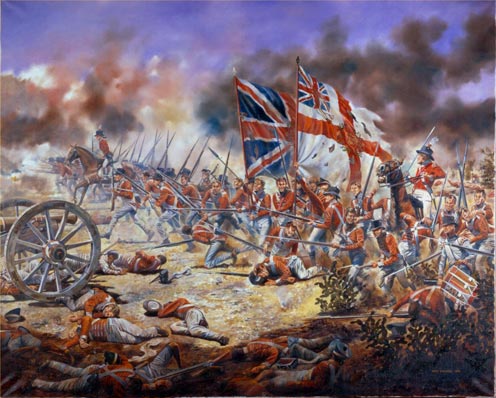
"The 74th Highlanders at the Battle of Assaye, 23 September 1803"
Ref: DR018
by David Rowlands
Image Size: 58 x 38 cm
The 74th (Highland) Regiment of Foot wore kilts and plaids of Government tartan from the time that they were raised in 1787. However, they were soon ordered to India, where the regiment spent eighteen years. On arrival at Madras the kilt was discontinued as unsuitable. In 1803 the soldiers wore white linen trousers, and black round hats. Officers wore a sash over the left shoulder in Highland fashion, and were armed with a Highland broadsword. I have included a piper, still wearing his bonnet. Drummers wore jackets of reversed colours, which were white in the 74th.
All British regiments which wore white facings carried a regimental colour which consisted of St George's Cross upon a white field. A small Union was in the hoist canton, and the regiment's number in the centre, surrounded by a wreath of roses, thistles and shamrocks.
The regiment fought in many battles and sieges in India, and under Sir Arthur Wellesley fought its most famous battle at Assaye, where every officer present (save one) was killed or wounded, and the battalion was reduced to a mere wreck Under tremendous fire the regiment advanced steadily, though hugely outnumbered, and captured two lines of enemy guns. Clumps of cactus obstructed their progress, but they pushed on. When down to only a few men, they finally had to withstand a charge of the Mahratta cavalry, and only the charge of the 19th Light Dragoons saved the remains of the regiment.
The Mahratta army was finally driven from the field. Wellington later regarded Assaye as his greatest victory. It was the bloodiest battle for the number engaged that he ever saw. The distinguished conduct of the 74th Highlanders was recognised by the Honourable East India Company by the gift of a third or honorary colour, bearing in its centre the figure of an Elephant within a wreath of laurel.
